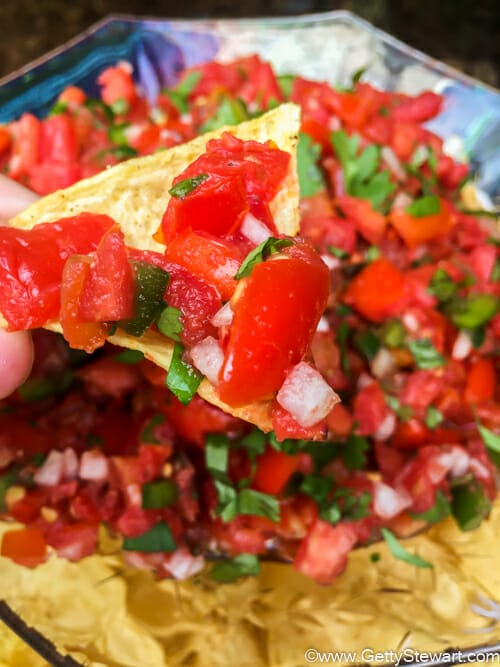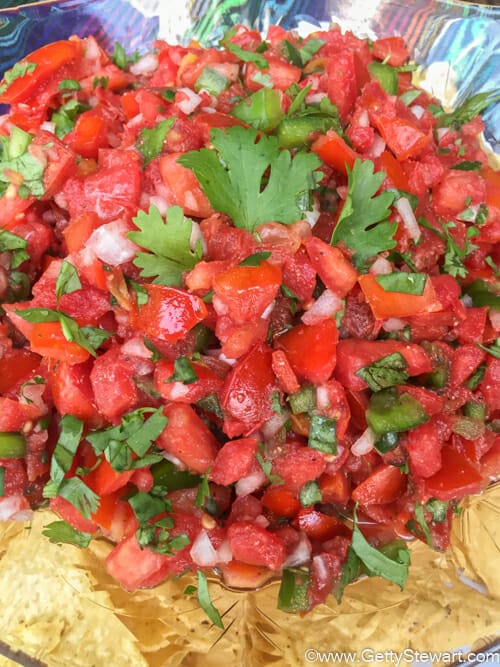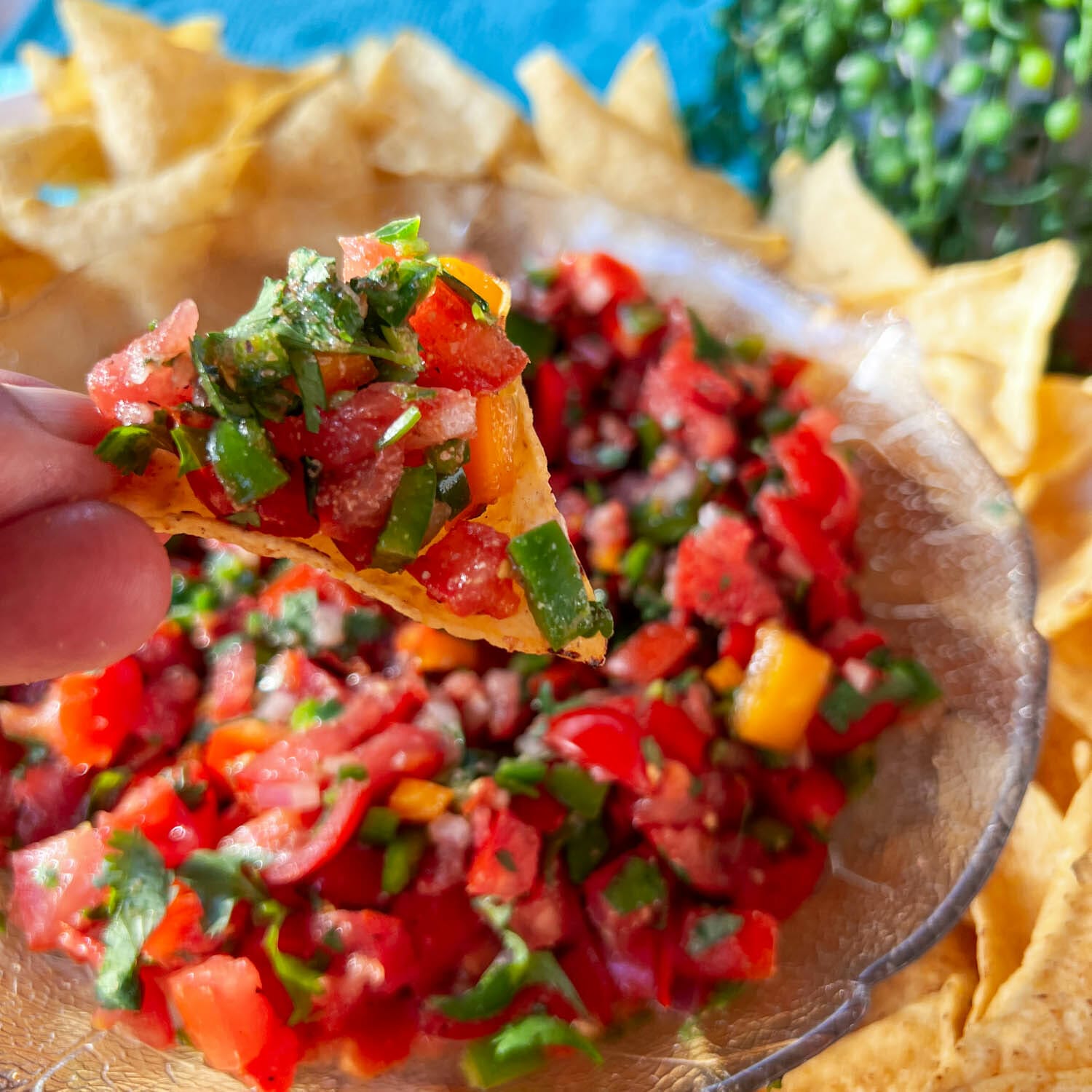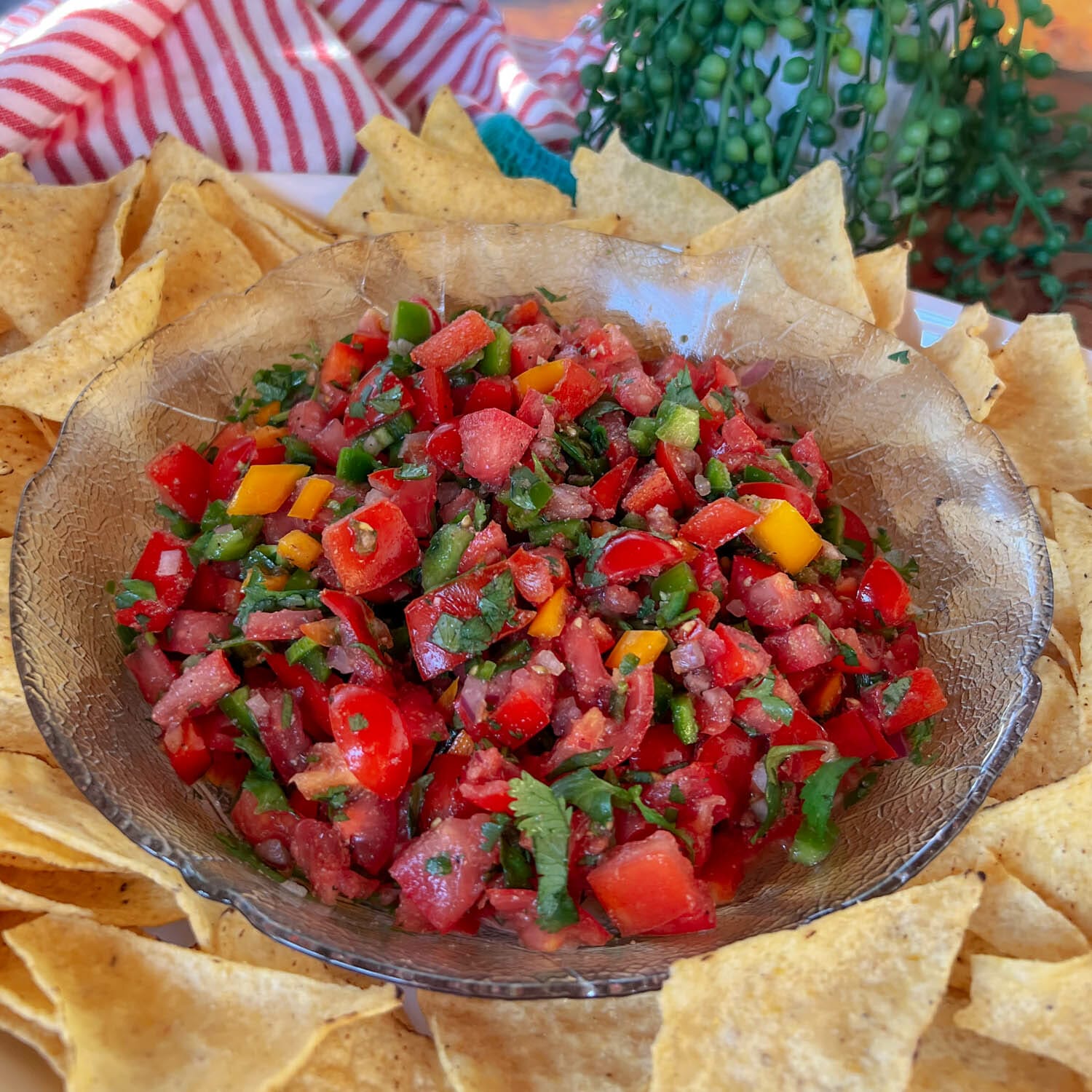Fresh Tomato Salsa or Pico de Gallo
Fresh salsa or pico de gallo is one of the first things I make when I have fresh garden tomatoes.

Also Read: Do’s and Don’ts of Canning Salsa, Freezer Salsa, Tomato and Corn Salsa, Panzanella Salad, Bruschetta.
Whether you’re getting tomatoes from the garden, a neighbour or a local market, be sure to try this tasty snack with this season’s star.

What Type of Tomato is Best for Salsa?
Ideally, paste or roma style tomatoes are best for salsa. They have thick, meaty walls with less juice and seeds inside. That means, more tomato and less juice. So, if you’re buying tomatoes for making fresh or canned salsa – buy paste tomatoes.
BUT! Any great tasting tomato will work. You can use cherry, grape or slicing tomatoes to make fresh salsa. If you’re really in a pinch, you could even use store bought tomatoes! And yes, you can mix and combine different colours and varieties.
Pro Tip: If you’re using large slicing or field tomatoes, remove some of the jelly/liquid and seeds to avoid having too much liquid in your salsa. Save the jiggly, juicy bits for making soups or stews.

What Type of Hot Pepper is Best for Fresh Salsa?
The great thing about making your own salsa is that you control the heat. Use your favourite type of hot pepper and add as much or as little as you’d like. How spicy you make it is totally your call.
Personally, I like just a little heat. I want to know it’s there, but I don’t want my tongue to be numb or so inflamed that I can’t taste anything else for hours. That’s why I typically use jalapeno, serrano or cayenne peppers.
A look at a scoville heat unit chart will give you an indication of just how hot a pepper is. Of course, it varies but generally speaking a jalapeno is about 3,500+SHU, a serrano is 10,000+SHU and a cayenne pepper is 25,000+SHU. That’s compared to a habanero at 200,000+SHU, a ghost pepper at 800,000+SHU or a Carolina Reaper at 2.2 million SHU.
How to to Adjust the Heat Level of Salsa
- Use a combination of sweet and hot peppers. Keep the overall amount in the recipe the same, but add in some sweet bell peppers for a milder sauce.
- Check the Scoville chart to determine where your peppers rank on the scale from mild to hot and choose accordingly.
- Remove the ribs and seeds for less heat. The highest concentration of capsaicin (the compound that makes hot peppers hot) is in the white ribs or membranes inside peppers. Because the seeds cling to these membranes, they’re often hot too, but the heat is really in those white ribs! You can choose whether to keep them or remove them.
- Add cucumbers, avocados, peaches, mango or other fruits and vegetables to add more flavours and fillers to the salsa.
- Add a little sweetness. While it won’t change the actual heat level, it makes our taste buds think there’s less heat.
- Add a little more acid. More vinegar, lemon or lime juice will help.
- Add a little tomato paste.
How to Get Thicker, Tastier Salsa
- Add some canned tomato paste. This will bind with some of the liquid and add a more concentrated tomato flavour as well. I do this when I use store bought tomatoes when I’m craving fresh salsa in the winter!
- Drain off some of the liquid after the salsa is made. Totally legit to do this!
- Remove some of the seeds and jelly when you’re cutting the tomatoes.
- Avoid using a food processor or blender to chop your ingredients – they’ll get too small and crushed releasing all their juices.
- Add avocados and mash in a little. This will make a more creamy salsa.
- Cook the salsa and evaporate some of the liquid. Note: this means it’s not fresh salsa anymore, but it will still be tasty!
- After cooking, you can dissolve 1Tbsp cornstarch/in 1 cup salsa and add to the cooked salsa and boil it for 1 minute only to thicken it.

Can I Can Fresh Salsa?
I haven’t found a tested recipe for raw or fresh salsa. If you do find one, the recommended processing time is likely two or three times longer than processing cooked salsa. Just think of the time it will take to get cold, raw salsa in a cold jar in cold water in your canner to come to a boil – 60 minutes at least. And that’s before you start the processing time. It would take nearly two hours on the stove to safely can fresh salsa – much better to the cook the salsa.
Can I Freeze Fresh Salsa?
It’s safe to do, but I don’t think you’ll be happy with the results. When you go to thaw your salsa, your crisp veggies and tomatoes will be quite soggy and not very appealing. It would be great to add to soups or stews, but not great for using as salsa.
You’re best bet is using this Freezer Friendly Salsa recipe. It’s a cooked salsa that freezes beautifully.
Recipe for Fresh Salas or Pico de Gallo
Fresh Tomato Salsa or Pico de Gallo
Ingredients
- 6-7 plum or Roma style tomatoes other varieties work as well see note below
- 1/2 onion
- 1/2 green yellow, or orange sweet pepper
- 1/2 to 2 cayenne or jalapeno peppers
- 2 cloves garlic
- 3 tbsp chopped cilantro or parsley
- 1 tbsp lime juice
- 1 tsp ground cumin
- 1/2 tsp ground coriander
- salt and pepper to taste.
Instructions
- Wash tomatoes.
- Slice tomatoes in half and remove seeds to limit the amount of liquid in your salsa.
- Dice tomatoes and toss in bowl.
- Chop onion, sweet peppers and hot peppers into small pieces and add to tomatoes.
- Mince garlic, add to tomatoes and combine all ingredients.
- Add cilantro/parsley, lime juice, cumin, coriander, salt and pepper.
- Mix well.
- Taste and adjust seasoning.
- Enjoy immediately. Remaining salsa can be covered and stored in the refrigerator. Drain any liquid that accumulates.
Notes
Nutrition Facts (per serving)
So, how do you like your salsa? Hot or mild? With lots of cilantro or just a bit of parsley? There is no right or wrong and the beauty of making it yourself is you get to make it just the way you like it! Let me know your favourites either down below or on Instagram @getgettys or Facebook @GettyStewart.HomeEconomist.
Sign up to get articles by Getty delivered to your inbox. You’ll get recipes, practical tips and great food information like this. Getty is a Professional Home Economist, speaker and writer putting good food on tables and agendas. She is the author of Manitoba’s best-selling Prairie Fruit Cookbook, Founder of Fruit Share, a mom and veggie gardener.



I half-double this recipe and used only 6 habaneros … it was almost un-eatably hot, and I like hot. Likely I should have removed the seeds and certainly would for another batch. Sad to have a whole kettle of salsa with wonderful organic ingredients that I might not be able to save.
Holy habanero! That’s more heat than I would be able to stand. I’ve learned to add peppers gradually and do repeated taste tests to avoid overpowering the recipe. If all else fails, freeze your salsa in ice cube trays then add a cube or two whenever you make chili or spaghetti sauce.